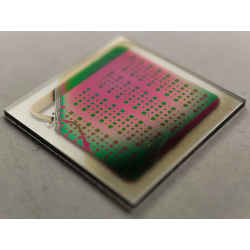
Lithium-ion batteries have emerged as a critical part of modern life. They provide the power to start and run vehicles, operate laptops and smartphones without a power cord, and run a vast array of other machines.
Yet, for all the convenience of lithium-ion batteries, they have some minuses—and they do not work particularly well in certain environments. As a result, researchers are charging ahead with new types of batteries. In January 2023, a group of researchers at the Vienna University of Technology (TU Wien) in Vienna, Austria, announced in a scientific paper that appeared in the journal Advanced Energy Materials that they had constructed a battery powered by an oxygen-ion process.
The device, made with non-combustible ceramic materials, absorbs and discharges doubly negative-charged oxygen ions. This makes the battery ideal for large storage systems, such as those built into electrical grids. While oxygen-ion technology is currently relegated to the lab, the researchers have already applied for a patent in conjunction with partner groups in Spain and France.
Says Alexander Schmid, a senior researcher at the Institute for Chemical Technologies and Analytics at TU Wien, "Oxygen-ion batteries will hopefully contribute to making sustainable, large-scale electrical energy storage feasible."
Gaining Energy
Today, lithium-ion batteries power the world. They are found in systems large and small. "Since 2008, there has been a 5x to 10x jump in volumetric density. This advance has made it possible to power increasingly small form factor devices for increasingly long periods of time," says Brandon Lucia, Kavčić-Moura Professor of Electrical and Computer Engineering at Carnegie Mellon University.
Lithium-ion batteries are not ideal for storage frameworks, such as homes, datacenters, and grids, however. The batteries can catch fire, there are sourcing concerns related to rare earth materials, and they are an environmental hazard. "There's a need to decrease dependence on rarer minerals that are difficult to source, including cobalt, which has been associated with human rights abuses," Lucia says.
In recent years, researchers have begun exploring the use of sodium, magnesium, potassium, and other materials to engineer new and different types of batteries. The TU Wien group began experimenting with oxygen-ion technology in 2021. "The project began as pure academic curiosity—as an illustrative demonstration of fundamental physics," Schmid explains. "Only later did we realize the great potential for practical application in the energy economy."
Although oxygen-ion batteries operate at a higher temperature (roughly 200 to 400 degrees Celsius) and they can store only about one-third the energy as a lithium-ion battery of the same size (and thus would likely require larger systems) they can be constructed from widely available materials such as iron, chromium, calcium, manganese, titanium, and strontium. In addition, it uses a solid electrolyte that is non-flammable.
The batteries also do not suffer from the same capacity loss that takes place over time with other types of batteries, including lithium-ion. "They have the ability to regenerate lost cell capacity from oxygen available in the atmosphere," Schmid says.
Oxygen-Ion charges ahead
Lab-scale oxygen-ion batteries are made by a pulsed laser deposition process that produces thin films. "It works by shooting a high-powered UV laser at a ceramic target. Due to the high energy, part of this target is evaporated and converted to a plasma," Schmid says. "This plasma then condenses on an often-heated substrate and forms a thin film of the same material as the ceramic target."
The system works like that of a lithium-ion battery, but it uses oxygen instead. The ceramic electrodes store and release oxygen ions as needed. Voltage regulates the flow of ions between ceramic elements. Electrical energy is stored by pumping oxygen ions from one ceramic electrode to the other. When these ions flow back, the battery releases the stored energy.
The most difficult task, Schmid says, was perfecting the sealing system. "It was a major engineering challenge in our current lab scale-model systems." The next major challenge, he adds, is scaling it up and adding electronic control circuitry or software that would produce a commercially viable battery system.
It will likely take the research groups several years to arrive at a commercially viable system. Yet, it's clear that the researchers have passed a key technical hurdle—and they're on track to build batteries that could support a far more sustainable energy framework that incorporates solar and wind power generating systems.
Though a variety of questions and challenges remain, Lucia describes the technology as "extremely promising"—particularly because of its resistance to degradation over repeated cycling and the environmental benefits. Adds Schmid: "We believe there is great potential for this technology."
Samuel Greengard is an author and journalist based in West Linn, OR, USA.



Join the Discussion (0)
Become a Member or Sign In to Post a Comment